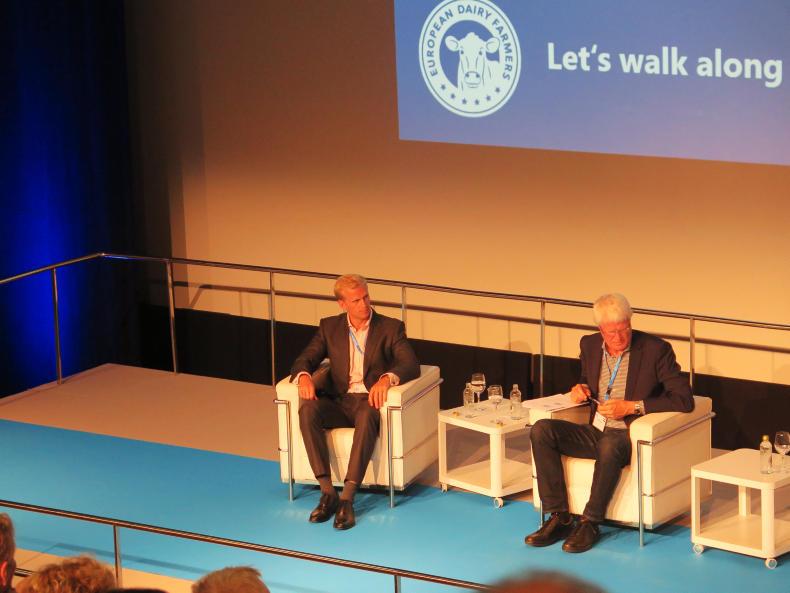Growth expectations in the three major dairy exporting regions is being tempered. This is according to James Caffyn, senior dairy consultant with Gira, a research and consultancy firm based in France.
Caffyn sights environmental restrictions in the developed economies of the EU, US and New Zealand as being the main factors why the growth in dairy output will slow. He says that the phosphate quota introduced in Holland is likely to be replicated in other EU countries.
Growth prospects
“We have downgraded our growth prospects from the US from 1.8% per annum to around 1.5% per annum. The main reason is environmental restrictions. Take the state of California, one of the largest dairy producers in the world, they are being hit with water shortages and restrictions,” Caffyn said.
He was speaking at the first day of the European Dairy Farmers organisation annual congress, being held this year in Santiago de Compostela in Spain, where the Irish Farmers Journal is in attendance,
The EU, US and New Zealand are still going to account for the largest growth areas for dairy, but at a slower pace. New Zealand is expected to grow by 0.9% per year over the next few years. Caffyn is predicting further growth in Argentina and that it will become a bigger player on the world market.
On the demand side, he is forecasting steady increases in demand for dairy products in China, southeast Asia and western sub-Saharan Africa.
Milk production in China
On China, he says that the government there is back encouraging the importation of dairy products as the cost of producing milk in China is too high.
The Englishman explained that the biggest threats to the dairy industry occur when politics, economics and food are intertwined, as is beginning to happen between the US and its partners, Canada, Mexico and the EU.
He thinks the new agreement between the EU and Mexico could be beneficial for the EU as Mexico is a major importer of dairy products.
Also speaking at the congress was Willem Koops, who compiles the LTO milk price comparison in Holland. He said that milk prices follow a three-year price cycle, with prices peaking in 2008, 2011, 2014 and looking like they peaked again in 2017.
He said that quotes for dairy prices have increased over the last few months, so he expects milk price at the farm gate to rise accordingly, as it always lags quotations.
Over 350 farmers from across Europe are attending the event, including eight member farmers from Ireland. The organisers present comparable costs of production between each country and visit farms in the host country.
Read more
'Brexit has the potential to create a new scale of milk crisis' – EDA
Dairy management: finding alternatives to grass
Growth expectations in the three major dairy exporting regions is being tempered. This is according to James Caffyn, senior dairy consultant with Gira, a research and consultancy firm based in France.
Caffyn sights environmental restrictions in the developed economies of the EU, US and New Zealand as being the main factors why the growth in dairy output will slow. He says that the phosphate quota introduced in Holland is likely to be replicated in other EU countries.
Growth prospects
“We have downgraded our growth prospects from the US from 1.8% per annum to around 1.5% per annum. The main reason is environmental restrictions. Take the state of California, one of the largest dairy producers in the world, they are being hit with water shortages and restrictions,” Caffyn said.
He was speaking at the first day of the European Dairy Farmers organisation annual congress, being held this year in Santiago de Compostela in Spain, where the Irish Farmers Journal is in attendance,
The EU, US and New Zealand are still going to account for the largest growth areas for dairy, but at a slower pace. New Zealand is expected to grow by 0.9% per year over the next few years. Caffyn is predicting further growth in Argentina and that it will become a bigger player on the world market.
On the demand side, he is forecasting steady increases in demand for dairy products in China, southeast Asia and western sub-Saharan Africa.
Milk production in China
On China, he says that the government there is back encouraging the importation of dairy products as the cost of producing milk in China is too high.
The Englishman explained that the biggest threats to the dairy industry occur when politics, economics and food are intertwined, as is beginning to happen between the US and its partners, Canada, Mexico and the EU.
He thinks the new agreement between the EU and Mexico could be beneficial for the EU as Mexico is a major importer of dairy products.
Also speaking at the congress was Willem Koops, who compiles the LTO milk price comparison in Holland. He said that milk prices follow a three-year price cycle, with prices peaking in 2008, 2011, 2014 and looking like they peaked again in 2017.
He said that quotes for dairy prices have increased over the last few months, so he expects milk price at the farm gate to rise accordingly, as it always lags quotations.
Over 350 farmers from across Europe are attending the event, including eight member farmers from Ireland. The organisers present comparable costs of production between each country and visit farms in the host country.
Read more
'Brexit has the potential to create a new scale of milk crisis' – EDA
Dairy management: finding alternatives to grass






 This is a subscriber-only article
This is a subscriber-only article












SHARING OPTIONS: